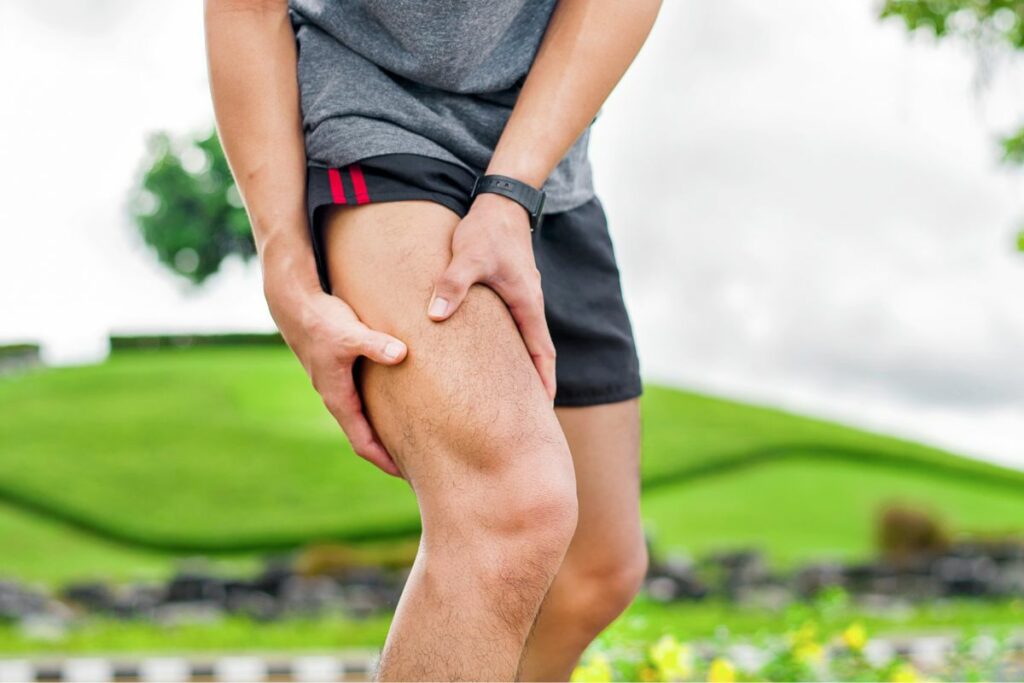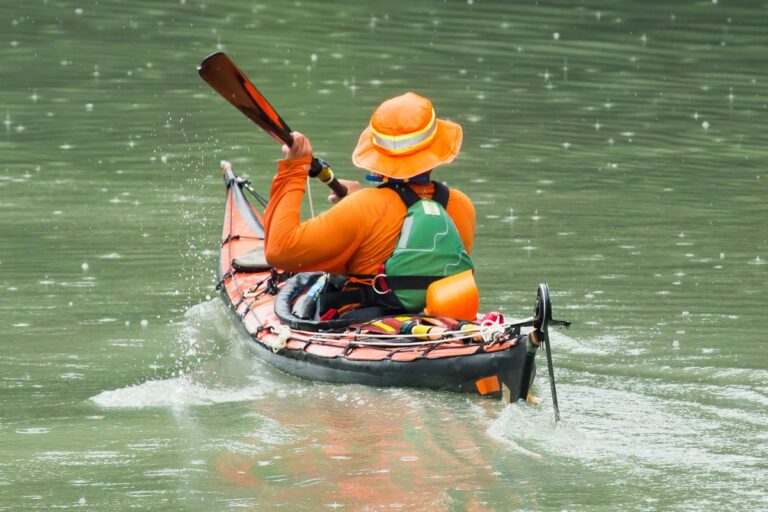Does Kayaking Work Your Legs? 6 Tips to Tone Your Legs Kayaking
Kayaking is often thought of as a leisurely activity that primarily engages your upper body, but in reality, it is much more than that.
So, does this mean that kayaking engages your lower body? Does kayaking work your legs? As a matter of fact, kayaking can provide a full-body workout that targets a variety of muscles in your body.
Kayaking works your legs as you rely on your lower body to control balance and stability in the kayak. It works your legs even harder if you have a pedal installed in your kayak, as the pedaling motion engages your quadriceps, hamstrings, and calf muscles, helping to build strength and endurance.
Keep reading to learn more about how kayaking is good for building muscle and how to tone your legs by kayaking without straining your muscles.
Table of Contents
Is Kayaking Good for Building Muscles?

Kayaking is good for building muscles as it’s a full-body workout that engages various muscle groups in your body, which leads to increasing your overall strength and improving your posture.
The Main Muscles Groups That Kayaking Works
Kayaking engages multiple muscle groups, particularly in your upper body and core. So, let’s take a quick look at the main muscle groups that kayaking works:
- Arms and Shoulders: The repetitive motion of paddling engages the muscles in the arms and shoulders, including the biceps, triceps, and rotator cuff muscles.
- Back: The twisting motion of kayaking works the muscles in the upper and lower back, helping to improve posture and reduce the risk of back pain.
- Core: The stabilization required while kayaking engages the muscles in the core, including the abs, obliques, and lower back.
- Grip: Holding onto the paddle for extended periods of time can help improve grip strength in your hands and forearms.
How Does Kayaking Work Your Legs?
As you can see, kayaking does not just rely on your upper body muscles but various other muscle groups, providing a full-body workout.
Now the question is, how does your lower body, particularly your legs, come into play when kayaking?
Kayaking works your legs as you tend to rely more on your lower body to control balance and stability in the kayak. There are also some kayaking techniques that require repetitive leg movements, such as knee lifts and scissor kicks, which engage different muscles in the legs.
Additionally, if you’re kayaking with a pedal system, the pedaling motion engages the legs and lower body, working different muscles such as the quadriceps, hamstrings, and calf muscles.

Here’s a detailed breakdown of different leg muscles and how kayaking works them:
| Muscle Name | Where It Is | How It’s Worked |
| Quadriceps | The large muscles in the front of the thighs that are used to extend the knee. | Engaged during pedaling. |
| Hamstrings | The muscles in the back of the thighs are used to bend the knee. | Engaged during pedaling. |
| Calf Muscles | The muscles in the lower leg are used to flex the foot. | Engaged during pedaling. |
| Glutes | The muscles in the buttocks. | Engaged when maintaining balance and stability in the kayak. |
| Hips | The muscles in the hips. | Engaged when maintaining balance and stability in the kayak. |
Can You Get Toned Legs By Just Kayaking?
Toning refers to the process of reducing body fat and building muscle, which requires a combination of exercise and a healthy diet.
While kayaking is a great form of exercise that works the legs, it may not provide enough resistance to build significant muscle mass and tone the legs on its own. So, in order to get toned legs, it is recommended to combine kayaking with other forms of strength training and cardiovascular exercise.
Additionally, following a healthy diet and drinking plenty of water, getting enough sleep, and managing stress levels are important factors that can affect muscle-building muscle and your overall health.
Tips to Tone Your Leg Muscles (And Other Muscles) By Kayaking

Here are some tips you can follow to tone your leg muscles (and other muscles) by kayaking:
- Incorporate strength training: Incorporating strength training into your routine can help build muscle and tone the legs. This can include exercises such as squats, lunges, and leg presses, which can help target the leg muscles.
- Vary your workout: Varying your workout can help prevent boredom and target different muscle groups. This can include switching up the types of kayaking you do, such as doing sprints or incorporating intervals, or adding other forms of exercise, such as running or weightlifting.
- Focus on technique: Proper technique is important in kayaking to get the most benefit from the workout. Pay attention to your posture, body positioning, and the way you paddle to ensure you’re engaging the muscles you want to target.
- Increase resistance: Incorporating resistance training into your kayaking routine can help tone the legs and other muscles. This can include adding resistance bands or weights to your workout or using a kayak with a pedal system.
- Stay hydrated: Staying hydrated is important for overall health and can help you perform better during your kayaking workout. Make sure to drink plenty of water before, during, and after your workout.
- Eat a balanced diet: Eating a balanced diet that is low in processed foods and high in protein can help build muscle and reduce body fat, which is important for toning the legs and other muscles.
By following these tips, you can maximize the benefits of kayaking and work towards toning your leg muscles and other muscles in your body.
However, keep in mind that extent to which kayaking can help with toning muscles will depend on various factors, such as your weight and physical activity level, as well as the intensity and frequency of your kayaking sessions.
Remembering that bodies are different and may progress at different rates is also important. The key to good results is remaining consistent with your exercise program and maintaining a healthy lifestyle.
What Does It Mean If Your Legs Hurt After Kayaking?

If your legs hurt after kayaking, it may be due to a variety of reasons, including:
- Kayaking for too long without taking breaks will put stress on the legs and other muscles, which can cause pain, swelling, and tenderness in the legs.
- Dehydration will make you more prone to cramping and muscle pain, especially in the legs.
- Overworking certain muscles while others are not being used can cause muscle imbalances, which can lead to pain and injury in the legs.
- Poor technique will put unnecessary stress on the legs and other muscles, leading to pain and injury.
- Lack of proper warm-up before kayaking will make you more prone to cramping and muscle pain.
If your leg pain is persistent or severe, it’s important to see a doctor or physical therapist to determine the cause and develop a treatment plan.
In mild cases, rest, ice, and over-the-counter pain relievers can help alleviate leg pain after kayaking. However, in more severe cases, physical therapy or other medical treatments may be necessary.
How to Avoid Muscle Strain from Kayaking?
Here are some tips to help you avoid muscle strain from kayaking:
- A proper warm-up can help prevent muscle strain and injury. So, focus on stretching and warming up the muscles you’ll be using during your kayaking workout, including the legs, arms, and back.
- Proper technique is important in kayaking to prevent muscle strain and injury. So, pay attention to your posture, body positioning, and the way you pedal to ensure you’re not putting unnecessary stress on the muscles.
- Gradually increasing the intensity of your kayaking workout can help prevent muscle strain. Start with shorter, less intense workouts and gradually increase the duration and difficulty as your muscles become stronger.
- Cross-training can help build strength and reduce muscle strain. So, it’s recommended to incorporate other forms of exercise, such as running, weightlifting, or yoga, into your routine to target different muscle groups and prevent overuse.
- Staying hydrated is important for overall health and can help prevent muscle strain. So, make sure to drink plenty of water before, during, and after your workout.
- Stretching can help prevent muscle strain and increase flexibility. So, make sure to stretch the legs, arms, and other muscles you use during kayaking on a regular basis.
Following these tips can minimize the risk of muscle strain and injury from kayaking. It’s important to listen to your body and stop if you experience pain or discomfort during your workout.
Kayak your way to Freedom
- On a budget? Check out the best fishing kayaks under $500 here and the best Fishing Kayaks under $1,000 here. Or Check the best Cheap Kayaks here.
- Going fishing? Here are the best Ocean fishing kayaks, and here are the best River Fishing Kayaks.
- You can also find the best Fly Fishing Kayaks here and the best Bass Fishing Boats here.
- A bit experienced? Check out the best modular kayaks here and the best tandem fishing kayaks here.
- Looking for something special? Check out my favorite Ducky kayaks here.
- Navigate your way with these awesome and beginner-friendly Kayak compasses.
- Going Hunting? These Duck hunting kayaks will give you an unfair advantage!
- Have a need for speed? These motorized kayaks will get you moving.
- Protect yourself from the sun with these Kayak shades, and make your kayak more comfortable with these Kayak seats.
- Keep your feet dry and warm with these superb Kayaking shoes.
- Going Kayaking in cold water? Stay warm with these Kayaking gloves.
- Paddle Less, Fish More with the Best Kayak Motors
- Looking to get a trolling motor on your kayak? Check out the best kayak trolling motor mounts here.
If you like this article, please share it or pin it, you can find the share buttons below. We will really appreciate it ❤️








